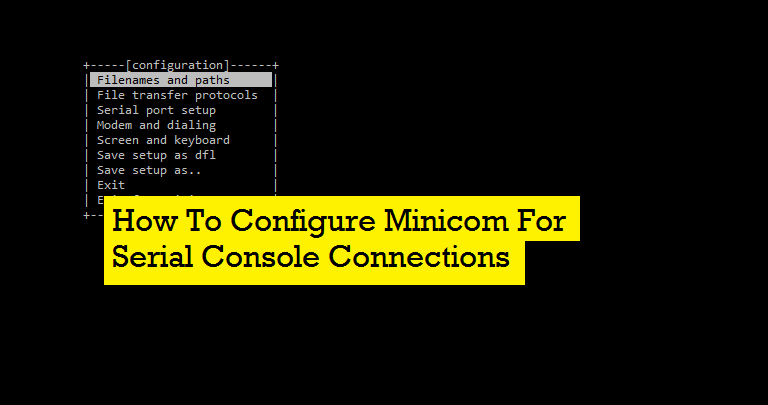

usr/bin/xgettext checking for catalogs to be installed.

yes checking whether included gettext is requested. no checking return type of signal handlers. yes checking whether setvbuf arguments are reversed. yes checking whether struct tm is in sys/time.h or time.h. yes checking whether sys/time.h and sys/select.h may both be included. yes checking whether time.h and sys/time.h may both be included. none needed checking for function prototypes. no checking for gcc option to accept ANSI C. gcc -E checking whether gcc needs -traditional.
#Minicom mac how to
yes checking how to run the C preprocessor. yes checking whether the C compiler (gcc ) is a cross-compiler. gcc checking whether the C compiler (gcc ) works. usr/bin/install -c checking whether build environment is sane. config.cache checking for a BSD compatible install. 二、为pc安装lrzsz lrzsz is a unix communication package providing the XMODEM, YMODEM ZMODEM file transfer protocols.
#Minicom mac Offline
| | | | Written by Miquel van Smoorenburg 1991-1995 | | Some additions by Jukka Lahtinen 1997-2000 | | i18n by Arnaldo Carvalho de Melo 1998 | +-+ CTRL-A Z for help |115200 8N1 | NOR | Minicom 2.4 | VT102 | Offline Press CTRL-A Z for help on special keys 按Ctrl-A,再按z,可以获取到minicom CTRL-A命令的帮助信息 Welco+-+ | Minicom Command Summary | OPTIO| | Compi| Commands can be called by CTRL-A | Port | | | Main Functions Other Functions | Press| | | Dialing directory.D run script (Go).G | Clear Screen.C | | Send files.S Receive files.R | cOnfigure Minicom.O | | comm Parameters.P Add linefeed.A | Suspend minicom.J | | Capture on/off.L Hangup.H | eXit and reset.X | | send break.F initialize Modem.M | Quit with no reset.Q | | Terminal settings.T run Kermit.K | Cursor key mode.I | | lineWrap on/off.W local Echo on/off.E | Help screen.Z | | Paste file.Y | scroll Back.B | | | | Select function or press Enter for none. 设置默认上传/下载的目录,选择Filenames and paths, 会看到这样的选项: +-+ | A - Download directory : /home/lingd/arm/download | | B - Upload directory : /home/lingd/arm/upload | | C - Script directory : | | D - Script program : runscript | | E - Kermit program : | | F - Logging options | | | | Change which setting? | +-+ 注意:开发板发送给pc的文件将保存在Download directory所设定的目录中,而pc要下载到开发板的文件保存在Upload directory所设定的目录中
#Minicom mac serial
| | Exit | | Exit from Minicom | +-+ 选择Serial port setup, 会看到这样的选项: +-+ | A - Serial Device : /dev/ttyS0 | | B - Lockfile Location : /var/lock | | C - Callin Program : | | D - Callout Program : | | E - Bps/Par/Bits : 115200 8N1 | | F - Hardware Flow Control : No | | G - Software Flow Control : No | | | | Change which setting? | +-+

#Minicom mac install
一、安装配置minicom 1、安装minicom sudo apt-get install minicom 2、配置minicom sudo minicom -s 出现这样的配置界面: +-+ | Filenames and paths | | File transfer protocols | | Serial port setup | | Modem and dialing | | Screen and keyboard | | Save setup as dfl | | Save setup as. I wish to use minicom which I have installed using ports to access a serial device connected to my machine (without having to fire up VMware and Windows just for this simple task!), but I can't determine which serial port I should be using in minicom - given that the /dev/tty.usbserial entry is not appearing.操作系统:Ubuntu 10.04 交叉编译器:arm-linux-gcc-4.1.1 If I fire up VMware the serial ports are there and correctly identified and if I connect them to my Windows VM they work fine. Nothing appears in the Networking pane of System Preferences.
#Minicom mac pro
When I plug them in, whether to a USB hub or USB port on the Mac Pro no entries appear in /dev at all.īoth devices appear in System Profiler with correct descriptions etc. I understand that when I plug the adapter into a usb port I should find an entry /dev/tty.usbserial or similar with a different string in place of "usbserial". I am running Leopard 10.5.6 on a Mac Pro. They are both FTDI based USB-serial adapters that are supported by OS X. I have two USB serial adapters that I'm using for a project I'm working on.


 0 kommentar(er)
0 kommentar(er)
